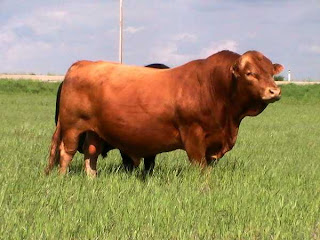| My Wikipedia Stub Article (Rosie Templeton, <http://en.wikipedia.org/wiki/Gelbvieh> retrieved March 22 2012) |
This project was extremely educational but did not come without challenges. My first obstacle was finding reputable sources online and compiling the facts into my own words. Thankfully, each source was fairly consistent in the history and basic information about the breed, so there were few contradictions in facts. Once I had gathered my main ideas into a document, I had to integrate it into the previous Wikipedia stub. In this case, the previous stub was poorly written and unsupported by references, so I found it best to remove the majority or their content and replace it with my findings. It was remarkably easy to do so, proving just how simply Wikipedia can be edited. I was also able to learn about linking to other Wikipedia articles through the previous editor's code. Another challenge came in the form of properly referencing my text. I added superscript reference notes using the reference template. After a few instances of trial and error, I found this method to be very easy to navigate. I liked that once I had cited a source once, I could simply pull it from the drop-down list to cite it again.
The highlights of this project were educating myself about a breed of cattle I knew little about, and learning the basics of Wikipedia editing. It's fascinating to learn how the modern North American cattle herd developed, and just how global our genetics are. I'm sure I can now impress most Gelbvieh breeders by telling them the story of how Lenness Hall visited Germany in search of new Fleckvieh bulls but instead became fascinated with the muscle capacity and length of body he saw in a Gelbvieh bull named Hass, prompting the first imports of Gelbvieh semen to America in 1971.
 |
| Gelbvieh Bull. <http://ranchers.net/forum/about47180.html> Retrieved March 22, 2012. |
My classmates have also been educating me on interesting topics in agriculture, human ecology, nutrition, and the environment through their own stub articles. I was particularly interested to see my fellow ALES 204 student Hilary's page on clubroot, a common plant disease which was first identified in Alberta in 2003. I learned from Hilary's article that this is no new disease, tracing as far back as 13th century Europe.
I appreciated learning about the inner workings of Wikipedia, and how incredibly easy it is for anyone with a computer to edit content. I understand that there are quality control measures and an active editing community in place, but it still seems very simple to change content from fact to opinion or even falsify facts. There was no screening for me to acquire a username; they didn't even require my email! This project has made me much more critical of the information I find on Wikipedia. I now plan to double check any information in a Wikipedia article via a peer-reviewed article or journal. I have never cited Wikipedia as a source for an academic paper, nor do I plan to. I use it as a source to help me learn more about a topic as it is easy to navigate, but I believe it is not useful or appropriate as a reference. Overall, this assignment was very educational. All university students who use Wikipedia on a regular basis should have to complete an assignment like this one to better understand where their information is coming from.
